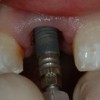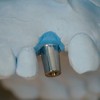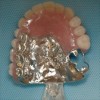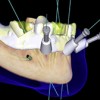There are several unique features of denture occlusion: tactile sense of occlusion is diminished, the denture sits on mucosa and is mobile, the teeth move as a unit, malocclusion affects the entire denture base immediately, non-vertical forces affect all the teeth and are traumatic and bilateral balance is desired for denture base stability. This program outlines the goals of complete denture occlusion and discusses the means of achieving these goals with a variety of tooth forms and tooth arrangements.
Complete Dentures – Concepts of Complete Denture Occlusion — Course Transcript
-
- 1. Concepts of Complete Denture OcclusionThis program of instruction is protected by copyright ©. No portion ofthis program of instruction may be reproduced, recorded or transferredby any means electronic, digital, photographic, mechanical etc., or byany information storage or retrieval system, without prior permission.
- 2. Differences between Natural and Complete Denture Occlusion Natural Dentition Denture “Dentition”n Retained in PDL n Mobile bases on mucosan Units move n Teeth move as an unit independently n Malocclusion affectsn Malocclusion effects not entire base immediately immediate n Non-vertical forces affectn Non-vertical forces all teeth and is traumatic affect only teeth involved and usually n Incising affects all teeth well tolerated attached to basen Incising doesn’t affect n Bilateral balance is often posteriors desired for base stabilityn Bilateral balance is rare n Decreased tactile sensen Tactile sensitivity
- 3. Goals of Complete Denture Occlusionn Minimize trauma to the supporting structuresn Preserve remaining structuresn Enhance stability of the denturesn Facilitate esthetics and speechn Restore mastication efficiency to a reasonable level
- 4. Types of Complete Denture Occlusionn Bilateral balancen Neutrocentric We prefer bilateral balance because this type of occlusal arrangement limits tipping of the dentures during parafunctional movements,
- 5. Bilateral Balanced Denture Occlusion The stable simultaneous contact of opposing upper and lower teeth in centric relation position with a smooth bilateral gliding contact to any eccentric position within the normal range of mandibular function, developed to lessen or limit tipping or rotation of the denture bases in relation to the supporting structures.
- 6. Bilateral Balanced Denture Occlusionn Traditionally bilateral balance was achieved with anatomic posterior denture teeth. However, it can be achieved with nonanatomic teeth using balancing ramps or by manipulating the compensating curve.
- 7. Bilateral Balanced Denture Occlusion with Anatomic Posterior Denture TeethProtrusive Balancing Workingn Bilateral Posterior Centric Contactn Centralized Forcesn “Balanced” Occlusion to minimize tipping Centric
- 8. Monoplane with Balancing Ramps Working BalancingBilateral balanced occlusion can Protrusivealso be obtained withnonanatomic posterior teeth ifbalancing ramps are employed. Inall lateral excursions you shouldobserve at least three points ofcontact bilaterally if bilateralbalance is to be achieved.
- 9. Lingualized Opposing Monoplane with Balancing RampsWorking Balancingn A similar concept is used when lingualized maxillary teeth oppose nonanatomic teeth in the mandible.In all lateral excursions you should observe at least three points of contact bilaterally to maintain bilateral balance.
- 10. Monoplane Occlusion (Neutrocentric Concept)This concept of occlusion assumes that the anterior-posterior plane of occlusion should be parallel to thedenture foundation area and not dictated by condylarinclination.The plane of occlusion is completely flat and level.There is no curve of Wilson or Curve of Spee(compensating curve) incorporated into the set up.There is no vertical overlap of the anterior teeth.When using this concept of occlusion the patient isinstructed not to incise the bolus. With this tooth
- 11. Monoplane Occlusion (Neutrocentric Concept) Centric BalancingAt balancing and protrusive positions there is separation ofthe denture teeth in the posterior regions leading to tippingof the dentures. This may be disadvantageous in thepatients exhibiting parafunctional grinding habits
- 12. Hanau’s Quintn Five Factors Affecting Occlusal Balance • Condylar Inclination • Incisal Guidance • Occlusal Plane Inclination • Compensating Curve • Cuspal Inclination
- 13. Hanau’s Quintn Inter-relationship of these five factors may be described by Theilman’s Formulan In order to maintain a balanced occlusion: Condylar Inclination x Incisal GuidanceC= OccPlane x Cuspal Inclination x CompCurve
- 14. Hanau’s Quint Factors controlled by the dentistn Of these five factors, the patient presents you with Condylar Inclinationn Occlusal Plane cannot be altered substantially since functional requirements dictate its position and orientationn The remaining three factors can be controlled by the dentist Condylar Inclination x Incisal Guidance C= OccPlane x Cuspal Inclination x CompCurve
- 15. Hanau’s Quint Factors controlled by the dentistn Of these five factors, the patient presents you with Condylar Inclinationn Occlusal Plane cannot be altered substantially since functional requirements dictate its position and orientationn The remaining three factors can be controlled by the dentist Condylar Inclination x Incisal Guidance C= OccPlane x Cuspal Inclination x CompCurve
- 16. Hanau’s Quintn Within the confines of esthetics and phonetics, minimize Incisal Guidance in Complete Dentures to minimize inclined tipping forcesn Adjust remaining factors to maintain balance Condylar Inclination x Incisal GuidanceC= OccPlane x Cuspal Inclination x CompCurve
- 17. Posterior Tooth FormsLingualizedMonoplane – neutrocentricMonoplane with balancing rampsLingualized opposing monoplaneSemi-anatomicAnatomic (30 degree)
- 18. Posterior Tooth Forms
- 19. Anatomic Tooth Forms
- 20. Nonanatomic Tooth Forms
- 21. Semi-anatomic Tooth Forms
- 22. Goals of Complete Denture Occlusionn Minimize trauma to the supporting structuresn Preserve remaining structuresn Enhance stabilityn Esthetics, Speech and Masticationn Enhance masticationIn addition we would like to decrease lateralforces to the residual ridges.
- 23. General Concepts of Denture Occlusionn Common Features • Functional anatomy is the main determinant of denture tooth position • Simultaneous, bilateral posterior contact in centric relation (centric occlusion) • Centralization of centric occlusal forces over the mandibular residual ridges n Buccal-Lingually
- 24. Is “Balance” necessary?Protrusive position Protrusive position Balanced vs Non-balanced occlusion occlusion
- 25. Is “Balance” Necessary? “Bolus in” “Balance out”
- 26. Is “Balance” Necessary?“Society is made up of happy neurotics,unhappy neurotics, and a few psychotics, and some of each become partially or totally edentulous.” Theodore Berg, Jr., D.D.S. * Balance is for Parafunctional Movements
- 27. Is “Balance” Necessary? Tests of Balanced and Non-balanced OcclusionsTrapozzano, V. R.: JPD 10: 476-487, 1960.1) No patient preference2) Balanced slightly more efficient3) Percentage of patients using eccentric movements during mastication is small
- 28. Is “Balance” Necessary?“Simplification of Occlusion in Complete Denture Practice: Posterior Tooth Form and Clinical Procedures” Dale Smith: DCNA 14: No. 3; July, 1970.1) Advocates cuspless teeth primarily for ease of use2) May use balanced occlusion but can’t prove that it is necessary
- 29. Balance and the Monoplane Occlusion Minimize vertical overlap within the dictates of esthetics and phonetics
- 30. Balance and Monoplane OcclusionMinimize vertical overlap within thedictates of esthetics and phonetics
- 31. Bilateral Balancen Anatomic posterior teeth vs Lingualized
- 32. Bilateral balance with anatomic denture teethBalancing side
- 33. Lingualized Occlusion Centric Occlusion Conventional LingualizedTheoretically, there should beless lateral displacement of thedenture and less lateral forcesduring function when usinglingualized posterior dentureteeth.
- 34. Setting the Maxillary Posteriors The lingual cusp tips should be in contact with the central fossae of the opposing mandibular teeth. The cuspal inclines of the mandibular teeth are relatively flat, resulting in potentially less lateral forces and displacement during function.
- 35. Lingualized Occlusion Working SideCentric Occlusion Balancing Side
- 36. Lingualized Occlusion
- 37. Lingualized Occlusion Indications for use Advantagesn High esthetic demands n Good estheticsn Severe mandibular ridge n Freedom of non-anatomic atrophy teethn Displaceable supporting n Potential for bilateral tissues balancen Malocclusion n Centralizes vertical forcesn Previous successful denture n Minimizes tipping forces with Lingualized Occlusion n Facilitates bolus penetration (mortar and pestle effect)
- 38. Complete Denture Occlusionn Investigators have not shown one type of denture occlusion to be : • superior in function • safer to oral structures • more acceptable to patients
- 39. Complete Denture Occlusionn Neuromuscular control may be the single most significant factor in the successful manipulation of complete dentures under function n Tongue function and denture wearing experience
- 40. v Visit ffofr.org for hundreds of additional lectures on Complete Dentures, Implant Dentistry, Removable Partial Dentures, Esthetic Dentistry and Maxillofacial Prosthetics.v The lectures are free.v Our objective is to create the best and most comprehensive online programs of instruction in Prosthodontics


 Single Tooth Defects in Posterior Quadrants
Single Tooth Defects in Posterior Quadrants
 Cement Retention vs Screw Retention
Cement Retention vs Screw Retention
 Implants and RPDs
Implants and RPDs
 Computer Guided Treatment Planning and Surgery
Computer Guided Treatment Planning and Surgery
